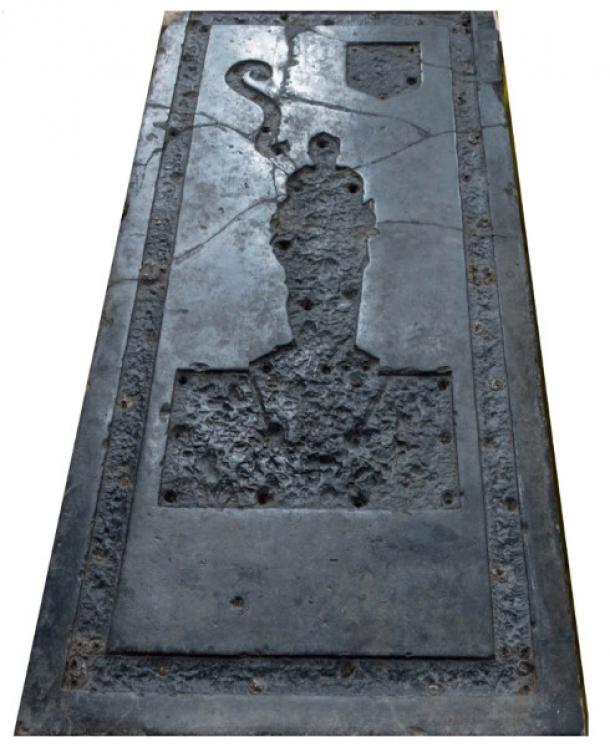🔴 Website 👉 https://u-s-news.com/
Telegram 👉 https://t.me/usnewscom_channel
There is a remarkable tombstone installed in a church in Jamestown, Virginia, the site of the first English settlement in North America in 1607. The tombstone dates to 1627, and is covered with carved depressions (once filled with brass inlays) that depict the outline of an English knight with a sword and shield.
But while the exact location of the first burial site has been lost, researchers have uncovered a fascinating piece of information about this 400-year-old memorial. They have determined that the limestone used to make the tombstone was quarried overseas in Belgium, before being shipped to London for later transport to the New World.
300-Million-Year-Old Fossils Reveal Existence of a Colonial Era Trade Route
In their new study, Dr. Marcus Key, a professor of natural philosophy from Dickinson College in Pennsylvania, and Dr. Rebecca Rossi from the California Geological Survey analyzed some chips of rock that came from the knight’s tombstone. They were searching for the remnants of ancient fossils, which are easily preserved in limestone.
“Due to the evolutionary process, biological species are much more unique through time and space than chemical elements or isotopic ratios,” Dr. Key explained in an interview published by Phys.org.
This approach proved highly successful. The researchers found traces of six microfossil species embedded in the pieces of rock, all of which were types of a Carboniferous Period lifeform known as foraminiferans. None of these species were native to North America, but 300 million years ago they would have been found in abundance in parts of an ancient ocean that covered the lands of two modern countries: Belgium and Ireland.
Given the connection between the stone and the British Isles, the obvious conclusion would be that the tombstone was brought to Virginia from Ireland. But in an article about their discovery published in the International Journal of Historical Archaeology, the researchers reveal that it actually came from Belgium, via an already-established 17th century ocean trade route.
“We hypothesize it was quarried and cut to size in Belgium, shipped down the Meuse River, across the English Channel to London where it was carved and the brass inlays installed, and finally shipped on to Jamestown as ballast,” they wrote. “This trade route was a small piece of the rapidly expanding Atlantic world of geopolitical colonial trade.”
Jamestown Knight tombstone. (Jamestown Rediscovery, Preservation Virginia/International Journal of Historical Archaeology)
In his interview about his and Dr. Rossi’s discoveries, Dr. Key explained that the motivation for their study was to uncover more information about trade in the earliest English settlements in North America. Studying tombstones seemed like a way to learn more, since it was known that elite English settlers would import the finest stones to create the most elaborate grave markers for themselves and their loved ones.
“We found that the oldest tombstone was the knight’s tombstone in Jamestown from 1627,” Dr. Key said.
“The particular historical archaeological question we were trying to answer was: How extensive was the trade network in the Chesapeake Bay during colonial times? Little did we realize that colonists were ordering black marble tombstones from Belgium like we order items from Amazon, just a lot slower.”
Has the Black Marble Knight’s Identify Been Discovered?
The knight’s unique tombstone was recovered during excavations in 1907 at the old site of the Jamestown Church. It measured 67 inches (172 centimeters) long and 31 inches (80 centimeters) wide, and featured carved depressions made for brass inlays in the shape of a knight, his weaponry, his family crest, and an unfurled scroll. The inlays had been removed from the grave marker long ago, possibly during Bacon’s Rebellion in 1676, which featured a lot of looting by Virginia settlers upset with the colonial government’s failure to purge all Native Americans from the territory.
Historical records indicate the tombstone had been relocated within the church in the 1640s. So it was not possible to identify the exact spot where the tomb had been installed and the knight buried two decades earlier.
The tombstone in the church in Jamestown, Virginia. (YouTube Screenshot)
It was common during this period for wealthy English colonists at Jamestown and elsewhere to order black “marble” tombstones for their family burials, as a way to signify their elite status. The Jamestown knight’s stone memorial was just one example, but it is the oldest one found and also the only one that marked the grave site of an authentic English knight.
Historical study has revealed the identities of two knights who lived and died during the period when the Jamestown Church was in use from 1617 through 1637.
One was Sir Thomas West, who served as the Jamestown’s first resident governor. He passed away in 1608 during a transatlantic voyage to the colony, and no historical records have emerged to suggest he was buried at the Jamestown Church.
The second individual was Sir George Yeardley, and some intriguing evidence strongly suggests the tombstone was made for him. This is in the form of a letter written by his step-grandson, Adam Thorowgood II, requesting a black “marble” tombstone for himself in the 1680s. He specifically requested that it should be engraved with the Yeardley family crest, and have the same inscription as the “broken tomb.”
When the black knight’s tomb was excavated in 1907, it was in fact found to be broken, which obviously fits perfectly with what was said in Thorowgood’s written correspondence.
George Yeardley first arrived in Jamestown in 1610. He served as the captain of Lieutenant Governor Sir Thomas Gates’s guard, and later became Virginia’s lieutenant governor himself. In 1617 he was officially named the governor of Virginia, before which he was knighted by King James I. Sir George served in that position in two stints that lasted from 1617 to 1621 and 1626 to 1627, with his death in the latter year ending his second term abruptly.
Yeardley’s importance certainly would have been reflected in his choice of a tombstone, and in his burial in such an exalted location. But because the site of the original burial remains unknown, none of the bones excavated at the site over the years can be definitively linked with the black knight’s tomb, making a DNA match with Sir George or anyone else impossible.
Given that Belgium is located 4,000 miles (6,300 kilometers) from the Cheseapeake Bay region of Virginia, it is clear that whoever ordered the grave marker wanted to make sure it was made from the finest polished limestone. While this was no doubt a costly import, it does reveal that colonial trade routes could deliver supplies from quite far away even in the early 17th century, when the English presence in the Americas was new.
Top image: Left; Knight in armor, Right; Jamestown Knight tombstone. Source: Left; LIGHTFIELD STUDIOS/Adobe Stock, Right; Jamestown Rediscovery, Preservation Virginia/International Journal of Historical Archaeology


